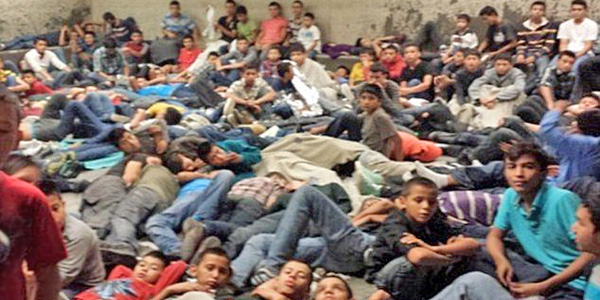The images of children crossing the U. S. border, sometimes accompanied by their mothers and sometimes alone, has gotten me thinking about Leslie Marmon Silko’s Almanac of the Dead. The novel is a dystopia foretelling increasing instability in the Americas. Among the characters are two twin brothers who, taking instructions from macaws and their own dreams, are walking north towards the U.S.-Mexico border followed by a “brown surge” of hundreds of thousands of people. Although they are “unarmed and humble as they walk[ ] northward to fulfill an ancient prophecy,” there are so many of them that no fence and no army will be able to stop them.
Silko is a Laguna Pueblo writer who believes that the Indian Wars have never ended in the Americas. She says that the Native Americans “acknowledge no borders; they seek nothing less than the return of all tribal lands.” As she sees it, the European settlers are just a blip in American history. The Indians were here long before the Europeans arrived and will outlast them. This is what is known as taking the long view.
Published in 1991, Almanac of the Dead is a grim novel that puts its finger on a number of the challenges we face, including unscrupulous realtors draining the aquifers, frightened millionaires retreating into gated communities and hiring private militias to protect them, and drugs-for-arms dealers whose lawlessness is driving people northward. It’s worth noting that, while the book appeared before all the talk of climate change, Silko predicts significant droughts.
Silko is best known for her 1977 novel Ceremony, which is more hopeful in that it concludes with a belief that Indian stories and Indian wisdom will save Indians and whites both. The author appears to have become much more pessimistic since then. Almanac of the Dead is unrelentingly grim unless you think that the reappearance of the Pueblo’s giant stone snake at the end of the novel presages some kind of hope. If nothing else, Almanac of the Dead provides a narrative articulating much of our current dysfunction.
Here’s a passage, set in Albuquerque, that seems particularly relevant today:
Albuquerque appeared to be booming. Sterling looked out the window at people walking to their cars from the shopping malls and from the K marts. The faces he saw were placid. The shoppers didn’t seem to have a clue about what was happening. Maybe they had noticed a few more U.S. government cars on the street, or increased military-helicopter flyovers, but that was all. On the West Side, Sterling could tell the people didn’t know either, because the faces had been excited, happy, even joking. They didn’t know, and Sterling knew even if someone told them, they would not believe it. Sterling had not believed the old prophecy either, but he had seen what was happening in Tucson with his own eyes…
What would these people in Albuquerque do when they heard about the twin brothers and their followers? How would the Native Americans and Mexican Americans in New Mexico react when the U.S. military opened fire on the twin brothers and thousands of their followers, mostly women and children? How many of these Chicanos and these Indians had ever heard the old stories? Did they know the ancient prophecies? It all seemed quite impossible, and yet one only had to look as far as Africa to see that after more than five hundred years of suffering, slavery and bloodshed, the African people had taken back the continent from European invaders. Sterling shuddered when he remembered the terrible price the tribal people of South African had had to pay while the nations of the world had stood back and watched.
Lecha warned that unrest among the people would grow due to natural disasters. Earthquakes and tidal waves would wipe out entire cities and great chunks of U.S. wealth. The Japanese were due to be pounded by angry earth spirits, and the world would watch in shock as billions of dollars and thousands of lives were suddenly washed away. Still there would be no rain, and high temperatures would trigger famines that sent refugees north faster and faster. The old [Mayan] almanac said “civil strife, civil crisis, civil war.” Allies of the United States would decline to intervene or send military aid. England and France would cite the distances and the costs and point out that no “armed force” threatened the U.S. border, only thousands of defenseless and hungry refugees from the war-torn South…Of course all of the northern European nations would find themselves in similar predicaments with massive onslaughts of refugees from the South.
In some ways, Silko shares an apocalyptic vision with those right wingers who also describe the current situation in extreme terms. I like to think that there are certain things we can do, such as working to promote economic and political stability in Honduras, El Slavador, and Guatemala, stemming the flow of guns into Central America, changing our strategies for dealing with drugs, passing comprehensive immigration legislation, and the like. Apocalyptic thinking can lead to fatalism or (if you see yourself on the right side of the apocalypse) magical optimism. But that being said, I find it unsettling that so much of Silko’s dark vision appears to be coming true.
Like all good dystopian literature, Almanac of the Dead can be seen as a wake-up call.
Added note: I’d forgotten that I’d applied Almanac of the Dead to the situation at the border two years ago. I repeat here some of the ideas in the previous post but the passages I use are different. You can go here to read it.


